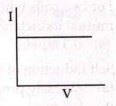The V-I characteristics of four circuit elements are shown. Which of these is ohmic ?




The correct Answer is:A
To determine which of the four circuit elements is ohmic based on their V-I characteristics, we need to analyze the graphs provided for each option. An ohmic element is one that follows Ohm's Law, which states that the current (I) through a conductor between two points is directly proportional to the voltage (V) across the two points. This relationship can be expressed mathematically as:
V=I⋅R
where R is the resistance of the conductor.
1. Understand Ohm's Law:
- Recall that for an ohmic conductor, the V-I graph should be a straight line passing through the origin. This indicates that as the voltage increases, the current increases linearly.
2. Analyze the V-I Characteristics:
- Look at the V-I characteristics of each of the four options provided.
- Identify which graph represents a linear relationship between voltage and current.
3. Identify the Straight Line:
- Check each option:
- Option 1: If this graph is a straight line, it indicates a constant resistance and therefore is ohmic.
- Option 2: If this graph shows a curve, it indicates a non-linear relationship, which means it is non-ohmic.
- Option 3: Similarly, if this graph is curved, it is also non-ohmic.
- Option 4: If this graph shows a horizontal line (current is constant regardless of voltage), it is also non-ohmic.
4. Conclusion:
- After analyzing all four options, the only graph that represents a straight line through the origin is Option 1. Therefore, this option is the only one that follows Ohm's Law and is classified as an ohmic circuit.
Final Answer:
The ohmic circuit is Option 1.
---
- Recall that for an ohmic conductor, the V-I graph should be a straight line passing through the origin. This indicates that as the voltage increases, the current increases linearly.
- Look at the V-I characteristics of each of the four options provided.
- Identify which graph represents a linear relationship between voltage and current.
- Check each option:
- Option 1: If this graph is a straight line, it indicates a constant resistance and therefore is ohmic.
- Option 2: If this graph shows a curve, it indicates a non-linear relationship, which means it is non-ohmic.
- Option 3: Similarly, if this graph is curved, it is also non-ohmic.
- Option 4: If this graph shows a horizontal line (current is constant regardless of voltage), it is also non-ohmic.
- After analyzing all four options, the only graph that represents a straight line through the origin is Option 1. Therefore, this option is the only one that follows Ohm's Law and is classified as an ohmic circuit.
The ohmic circuit is Option 1.
Similar Questions
Knowledge Check
The I−V characteristic of an LED is.
A B
B C
C D
D
The I-V characteristics shown in the figure represents
 Aohmic conductorsBnon-ohmic conductorsCinsulatorsDsuperconductors
Aohmic conductorsBnon-ohmic conductorsCinsulatorsDsuperconductorsI−V characteristics of four devices are shown in Fig.




Identify devices that can be used for modulation :A'I'and'iii'Bonly'iii'Cii'andsomeregionof'iv'DAll the devices can be used
1-V characteristics of four devices are shown in figure.

Identify devices that can be used for modulation
View Solution1-V characteristics of four devices are shown in figure.

Identify devices that can be used for modulation
View SolutionThe 1-V characteristic of an LED is shown as
View SolutionThe V-I characteristic of a silicon diode is shown in figure . The resistance of the diode at ID=15 mA is

View SolutionCurrent-voltage characteristics of two elements A and B are as shown below in Figs. (a) and (b).
(a)
Which of the following graphs represents current voltage characteristics for their series combinations ?
View Solution
